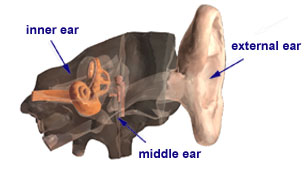Hearing and Balance
The 
The ear is divided into three parts: the , a middle ear, and an inner ear (cochlea and semicircular canals). Each part performs an important function in the process of hearing.
The external ear is made up of the auricle and ear canal. These structures gather the sound and direct it towards the tympanic membrane (ear drum).
The middle ear chamber lies between the tympanic membrane and the cochlea. It contains three small ear bones (or ossicles): malleus (hammer), incus (anvil) and stapes (stirrup). These structures transmit sound vibrations to the inner ear. In so doing, they act as a transformer, converting sound vibrations in the external ear canal into fluid waves in the inner ear.
The inner ear chamber contains tiny hearing and balance nerve endings bathed in fluid. The inner ear is a delicate, tissue-lined sense organ, which is encased in an outer hard bony shell. These two parts are suspended within the sponge-like ear bone (temporal bone). The inner ear is suspended in a fluid known as perilymph. Inside the membranous inner ear circulates another fluid called endolymph. 
The Mechanics of Hearing
Hearing occurs as sound enters the ear canal and sets in motion the vibration of the eardrum and middle ear bones. Motion begins in the entrance to the inner ear and produces a traveling wave, which activates the hair cells of the basilar membrane. It is the hair cells that convert the energy of sound into a neurologic (nerve) impulse, which can be understood by the brain. These impulses are transmitted through the cochlear nerve, via the brainstem, to the brain cortex. The hearing organ is the cochlea, which is a snail-like structure divided into three chambers. The three chambers are called the scala tympani, the scala media and the scala vestibuli.
The Mechanics of Balance
The balance portion of the inner ear is another delicate organ; it consists of the utricle, saccule, and 3 semicircular canals. Like the hearing portion of the inner ear, it contains fluid (endolymph) and is suspended in fluid (perilymph). This delicate organ is housed in three half circles of hard bone: the superior, lateral and posterior semicircular canals. At each end of the canals are structures that contain sensory hair cells. These hair cells are tipped with calcium deposits, which make the ends of the hair cells top-heavy and motion-sensitive. When the head is turned, endolymph moves through the semicircular canals past the hair cells. As these cells are stimulated, electrical impulses are transmitted through the balance nerve to the brain.
The brain acts as a computer, analyzing constant signals being sent its way from the semicircular canals. As the person changes position, the brain processes this information. Based upon the data received from the inner ear, the brain then sends messages to the muscles of the body to maintain balance. Any disturbance in inner ear results in hearing difficulties and/or balance difficulties.
For more information:
Go to the Ear, Nose, and Throat Disorders health topic.
